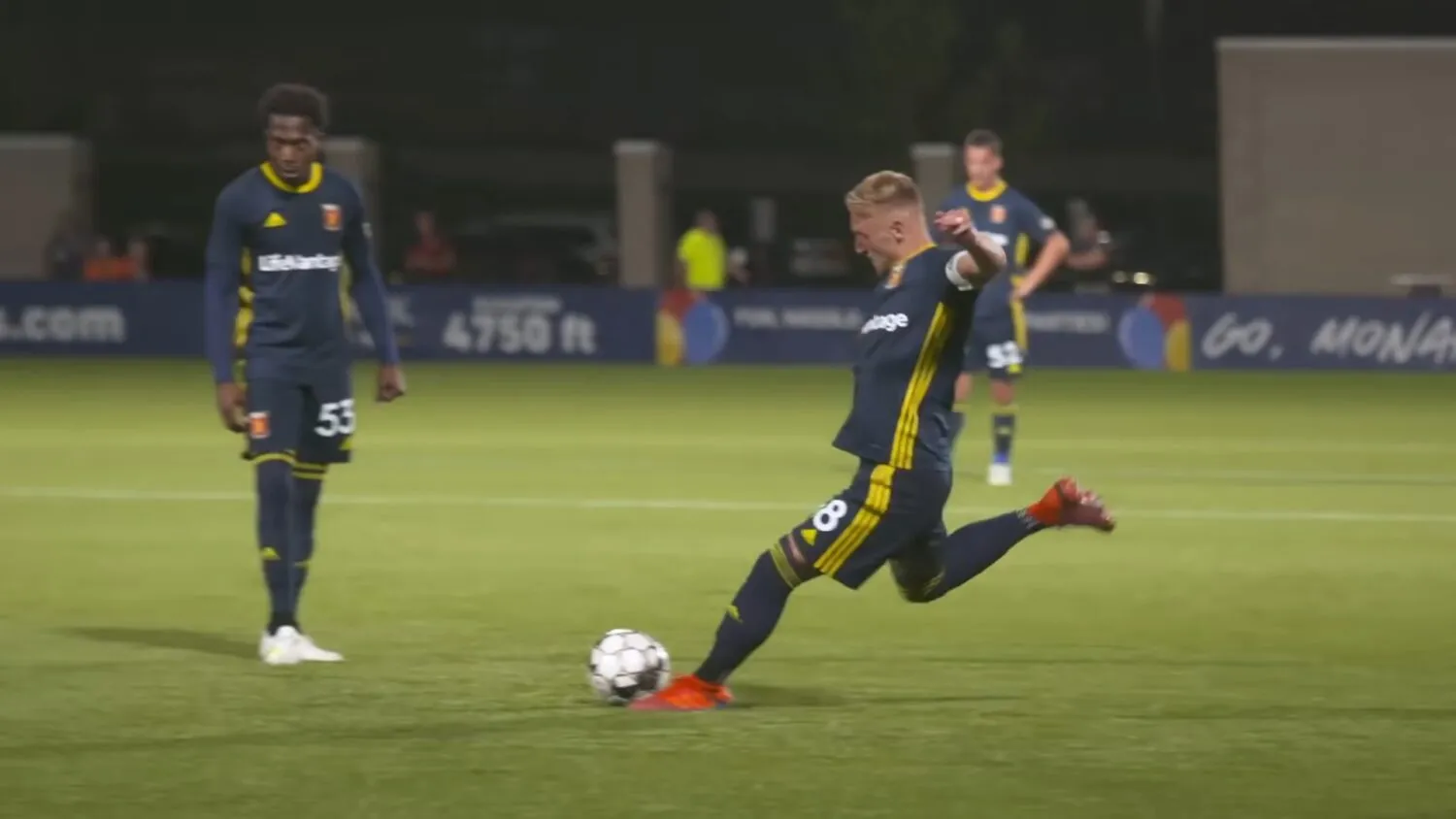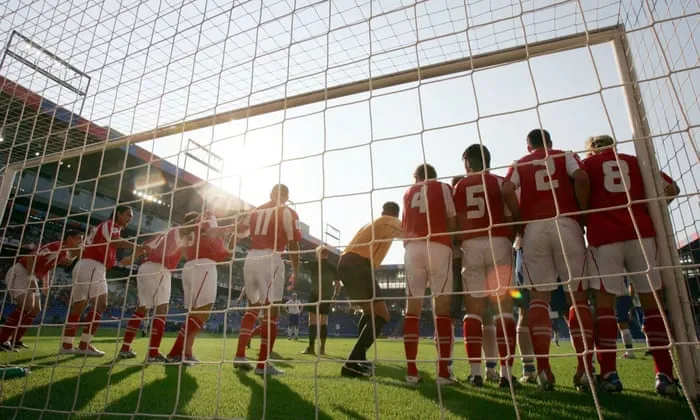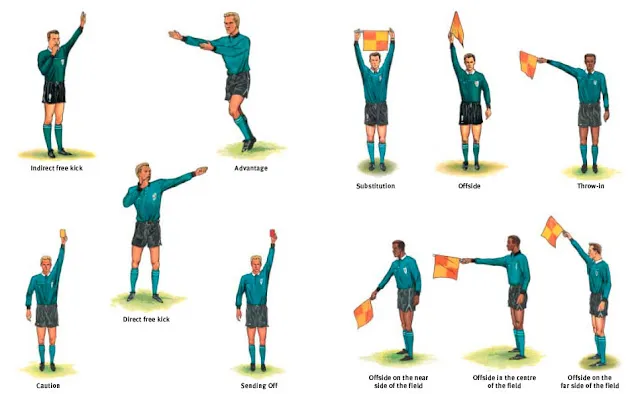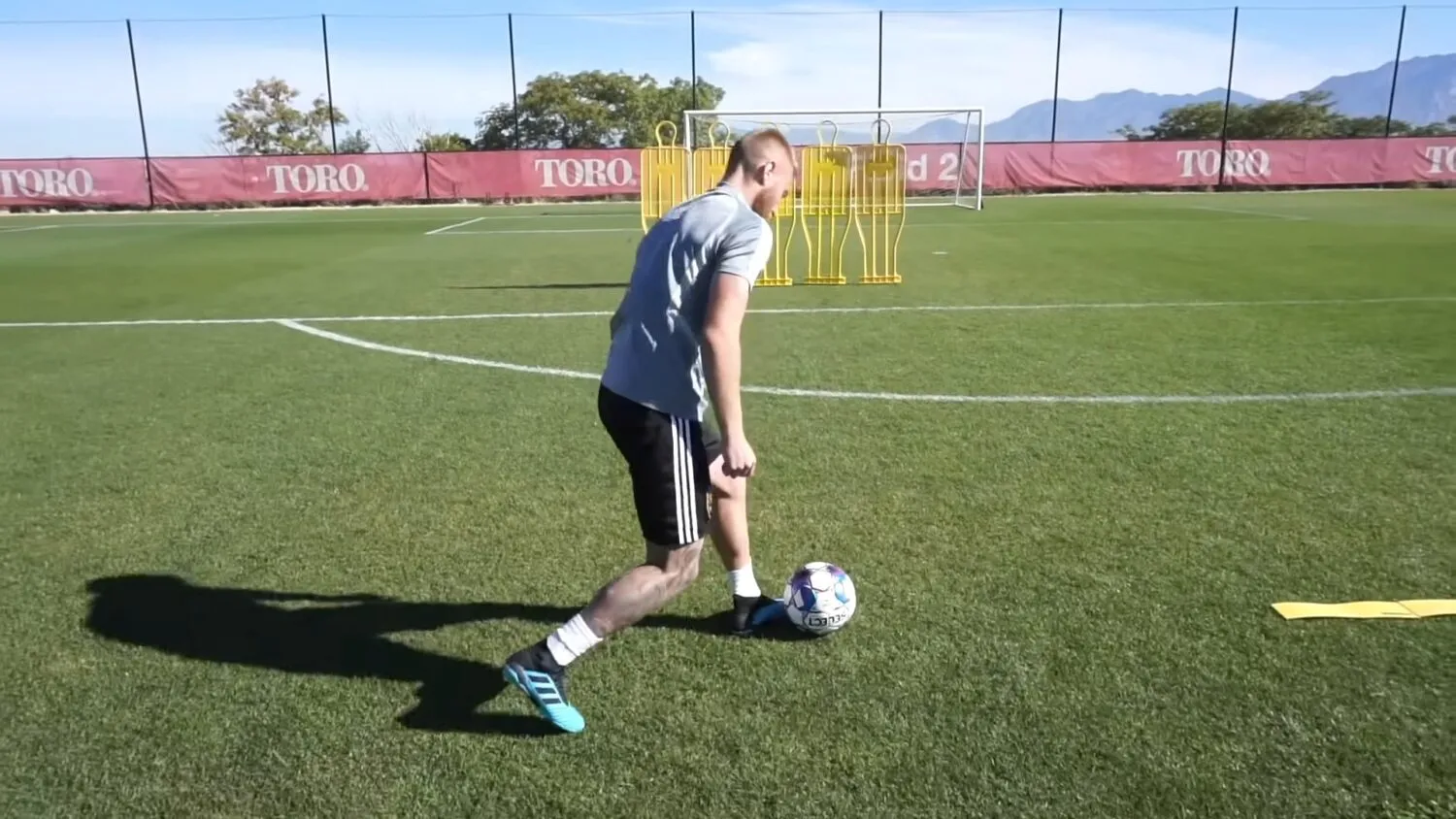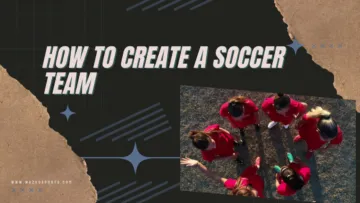Football is a diverse game. Sometimes, football terminology can cause confusion. A free-kick is one of these terminologies. What is a free kick in soccer?
You should have noticed when you are watching a football match that if a player commits fouls, the referee immediately stops play and gives the opposing team a free kick.
These are the two free-kick cases.
Direct free kicks are also known as the “number 1 type” of free-kick, while indirect free kicks are also known as the “number 2 type” of a free kick in football.
If the free-kick takes place with sufficient accuracy and power, it can prove to be very dangerous for an opponent. The only thing standing between the free-kick takers and the net in soccer is what’s known as a “free-kick wall“. But what exactly is it?
A soccer free-kick wall is a line of soccer players who stand close together and form a straight line in front of a free-kick taker. The goal of the free-kick walls is to make it more difficult for free-kick takers to score goals.
It is possible to form a wall during any dangerous soccer free kicks. Many teams opt to create free kick walls, even when they are far from the net.
What Is a Free Kick in Soccer?
After a foul is committed on the field, a free-kick allows soccer players to restart play. The type and severity of each foul determine whether the free kick will be direct or indirect. A free-kick is open to any player on the field. Defenders must be at least 10 yards from the spot where the ball is located.
Although the concept of free kicks seems simple, it is not always easy to call them. There are many rules and regulations that guide how they can be used. These aspects will be covered in more detail later on. We encourage you to continue reading.
Free kicks, as the name implies, are set pieces that allow play to resume after a foul has occurred in soccer. Free kicks can be either direct or indirect. Defenders should not set up closer than 10 meters from the spot where the foul occurred. Some offensive plays quickly restart the game and do away with the need to wait for the defense to move the ten yards.
This strategy is viable as it can be used to catch defenses off guard and out of position. Both strategies are acceptable because the goal of a free-kick was to give an advantage to the inflicted team.
There are many types of player-to-player contact fouls that can occur during a competitive soccer match. These include pushing, tripping, and others.
Referees assess the severity of each foul, interpret whether they were intentionally committed or not, and award direct or indirect free kicks depending on their perspective.
Coaches and players who are too vocal can result in penalty cards or their removal from the sport.
What Is a Direct Kick in Soccer?
The most common type is a direct free-kick in soccer. The referee will usually award a direct free kick to the majority of offenses.
It is very easy to define a direct kick.
Direct free-kick refers to a kick in which the kicker can score a goal right from the kick. The ball does not have to touch any other player before it enters the goal.
A goal is basically a goal that a player scores. Direct free-kick. The ball does not need to touch anything or anyone else until it reaches the goal.
Because soccer’s most common offenses lead to direct free kicks, a direct free kick is more common than an indirect one.
There are many offenses that can lead to a free kick. Here is a quick overview.
Referees will award a free kick if:
- A player is careless or reckless in their conduct.
- A player is found guilty of an offense by using excessive force
- A player is charged with a handball offense
- A player can hold or hinder an opponent using contact
What is an Indirect Kick in Soccer?
If a soccer player commits an intentional foul against a player of the opposing team, they are eligible for indirect free kicks.
The referee will blow their whistle to stop play, point their arm straight up in the air to indicate that it is an indirect kick, then instruct the offensive team to place the ball.
Direct kicks can be directed directly at the goal, but must not touch another player before they are allowed to cross the goal line.
The second touch is more often than not a player from the same team who makes an intentional pass or play.
Technically, the ball can be touched off the indirect kick by an opponent player, but it must still enter the goal to be considered a goal. An example would be a ball landing on the net after hitting a defender’s feet.
These are some common situations that can result in an indirect kick:
- An opposing player slides tackles a player from the front
- A defender is someone who blocks someone from getting the ball, but not playing the ball.
- One player fights for the ball with an opponent player using his/her cleated foot at dangerous heights
- After a teammate has kicked the ball to them, the goalkeeper grabs it with both hands.
When setting up for indirect kicks, offensive players must be aware of their position and that of their defenders. Indirect kicks are a common opportunity for teams to develop strategies and plays.
It is equally important to learn defensive strategies to protect against indirect kicks. These could include pulling back or high-pressure pressing from the first pass.
Direct and indirect free kicks: The mystery behind their existence
A free kick is given to the opposing team for every offense committed by one team. The question is: What type of free-kick was awarded? And how do you carry out this free kick?
This question is dependent on the type of offense. The referee will decide which free kick should go after analyzing the offense.
If the free kick awarded is number 1 or direct, you can shoot straight into the goal without passing the ball to anyone. This is why it is considered the number 1 free-kick.
You may be wondering what happens if an indirect free kick is shot directly into the goal. In that case, the opposing team will receive a goal kick.
A second important point to remember is that if fouls are committed within the penalty area, then instead of a kick being awarded, a penalty kick will be given.
Free Kick Signals
Okay, so now a foul has occurred and players look at the referee to decide if the offense is worthy of a free kick or a direct one.
Once he’s made his decision, he must signal to the players which type of free-kick he’s giving. He has two options for signaling the players: one for the direct kick and another for an indirect kick.
Direct free kick signal
The referee will blow his whistle and raise his arm horizontally to signal a free-kick. Players instantly recognize that this signal is a direct kick.
Indirect Kick Signal
The referee will blow his whistle and raise his arm vertically over his head to signal an indirect kick signal. This signal is given to players to indicate that an indirect kick has been awarded.
Rules for free kicks
The main referee is the one who signals free kicks. The foul victim does not have the right to a free-kick.
It is important to be able to accurately and quickly assess the leg strength of each team member, especially when you are kicking the ball.
The ball must be in a fixed position once a foul has been called. Without the ball being stopped, the offensive team can no longer continue the play of the game.
If a team plays without stopping, the referee will blow his trumpet and direct the offensive team to place the ball. Then, he will blow his whistle again to restart the play.
Until the ball touches the ball, opposing players must be at least 10 yards from the spot where the ball is placed. If the kick taker doesn’t believe the defenders are within 10 yards of the ball’s spot, they can ask for the referee to measure the distance.
The defensive team is allowed to form a wall, where players stand shoulder-to-shoulder, in an attempt to block the ball from reaching the goal.
The ball must be played in a reasonable time with free kicks. The offensive team can take a kick immediately and continue playing. They also have the option to wait for 10 yards for the opposing team’s retreat to allow them the time and space to plan where and how to place the ball.
Although there is no time limit for the ball to be played, too much waiting can lead to a penalty card for the delay. If this happens, the ball is returned to the opposing team.
Free kicks do not allow for substitutions. Free kicks are awarded to teams that have been fouled.
Substitutions are not permitted to impede the forward movement of the ball. Substitutions are not allowed in a game if the ball is kicked beyond the goal lines or goes out of bounds.
Here’s a quick reference to free kick rules:
- Referees call a foul by blowing their whistle. They signal a kick with their arms or direct kick.
- Before you can restart play, the ball must remain stationary on the ground.
- Any member of an offensive team can kick a direct or indirect ball
- If the offensive team is restarting quickly, the defenders must stay at least 10 yards from the ball.
- Indirect or direct kicks, no substitutions of players are permitted
- Indirect kicks may be directed directly to the goal. Direct kicks, however, must touch another player before they cross the goal line.
Free kicks are common in competitive soccer. It is important that you understand both the direct and indirect types of free kicks as well as the rules.
Once you have both, it is possible to develop player strategy and player development on both the offensive and defensive sides of the ball.
What causes a direct free kick?
If a player from any team is found guilty of an offense, the opposing team receives a free kick.
Let’s take a closer look at the reasons why a free kick may be given.
Committing a Hand Ball
Only the goalkeeper, also known as the goalkeeper, is permitted to touch the ball with their hands. A handball is a foul that can only be committed by a player. The goalkeeper will award a free-kick to the team who has received it.
Use of unnecessary extra force
Referees often award free kicks because of an unruly player. Referees can award free kicks if a player is deemed to have used excessive force or recklessness.
Pushing or jumping at an opposing player.
An attempt to strike or kick an opponent player.
It is unnecessary to hold onto an opponent player.
Tripping or trying to trip another player is a grave offense.
Interfering in the play or entering the pitch
This is an unusual case. This is a rare case, but we have seen it so this must be considered.
No one can enter the pitch or interfere in play under any circumstances. If a substitute or an official from a team enters the pitch without the permission of the referee, the opposing team is entitled to a free-kick.
Imprudent Behavior
A free kick is given to the opposing team if any player is found guilty of acting rashly or causing distastefulness within the peaceful game environment.
These actions include
- Spitting at opponent
- An opponent is guilty of a physical offense
- Throw a ball or object at an opponent or referee
This behavior is unacceptable and can often lead to a yellow or red card for the player.
What causes an indirect free kick?
There are many reasons that an indirect free kick may be granted. These are rarer than direct free kicks because the offenses that result in indirect free kicks rarely occur.
- The following are the infractions that result in an indirect free kick being awarded to the opponent:
- An indirect free-kick will be awarded to a player who is caught offside. This is the most common reason for an indirect free kick being given to the opposition.
- Goalkeepers illegally handling the ball
- Impeding a player of an opposing team without any physical contact
- Discord between a player or match official, or between more than one player.
- One player tried to kick the ball, while the goalkeeper released it.
- Tried to impede the goalkeeper as he released the ball.
- Reckless play does not automatically mean you are committing any offense or foul.
- Harmful or offensive words and actions towards other players.
- You may enter the pitch without the permission of the match referee, but you are not allowed to interfere with the play.
- A player who tries to distract or block another player during a throw-in.
- There are many other infractions that can result in an indirect free kick being awarded to the opposing team.
These infractions can lead to penalties that trigger the match referee’s award of indirect free kicks for the opposing team.
These infractions include
- A penalty was not able to move forward.
- A player took a penalty to distract from the goalkeeper, which was an illegal feint.
Conclusion
A team can use the free kick wall to defend against an opponent who gets a free-kick. To stop the free-kick taker scoring, the wall is made up of several soccer players standing in a straight line.
Also Check our top picks for best football ankle braces.


